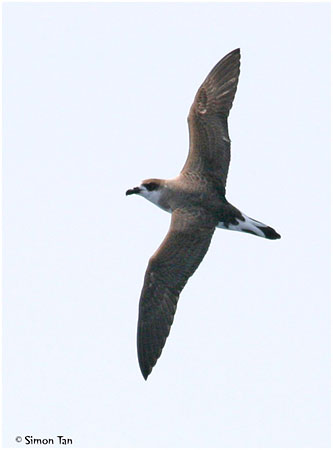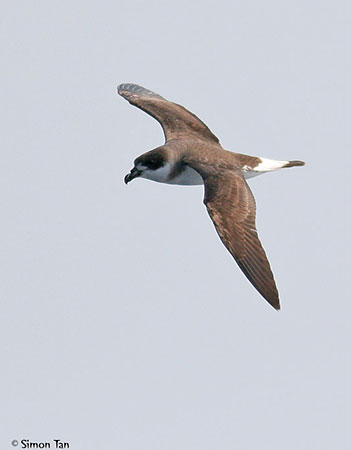
Fr: Pétrel diablotin
Ang: Black-capped Petrel
All: Teufelssturmvogel
Esp: Petrel Antillano
Ita: Petrello dal cappuccio
Nd: Zwartkapstormvogel
Sd: karibpetrell
Photographer:
Simon Tan
PBase Bird galleries
Text by Nicole Bouglouan
Sources:
HANDBOOK OF THE BIRDS OF THE WORLD vol 1 by Josep del Hoyo-Andrew Elliot-Jordi Sargatal - Lynx Edicions - ISBN: 8487334105
Neotropical Birds – Cornell Lab of Ornithology
Wikipedia, the free encyclopaedia
What Bird-The ultimate Bird Guide (Mitchell Waite)
All About Birds (Cornell Lab of Ornithology)
West Indian Breeding Seabird Atlas
Page family Procellariidae
Summary cards
Black-capped Petrel
Pterodroma hasitata
Procellariiformes Order – Procellariidae Family
INTRODUCTION:
The Black-capped Petrel is a rare and secretive petrel in the Western Hemisphere. It spends most of its life flying over water. It returns to land only for breeding at hidden sites in the mountains of Hispaniola. This species is the only Procellariidae known to breed in this region. The breeding populations are small and fragmented, and probably declining. The Black-capped Petrel forages over deep waters along upwelling current edges, and is often seen in mixed-species flocks.
It is threatened by habitat loss on its breeding grounds, and there are currently only three remaining nesting areas on Hispaniola, but other sightings may suggest that this species nests at other sites.
We can find two morphological types within P. hasitata, black-faced and white-faced types. They differ in morphology and moult timing.
The Black-capped Petrel is also locally known as “diablotín” or “little devil”. It is listed as Endangered.

DESCRIPTION OF THE BIRD:
Biometrics:
Length: 40 cm
Wingspan: 98-105 cm
Weight: M: 329-591 g – F: 347-545 g
The Black-capped Petrel has blackish-brown back, upperwings and tip of tail. The upper rump is darker, whereas the lower rump and the uppertail-coverts are white.
The underparts are entirely white, but on the white underwings, we can see a narrow dark trailing edge, a broad black leading edge between primaries and carpal join, and black wing tips.
The head is brownish-black, extending to eye and nape, and towards the upper breast while forming a partial dark collar. Forehead and lores are white. This pattern gives the bird strongly capped appearance. The hindneck usually forms a white hind collar, but it is sometimes absent or only paler than the head.
The hooked bill is black. The eyes are dark brown. The legs are pink, while the feet are mostly black.
Male and female are similar.
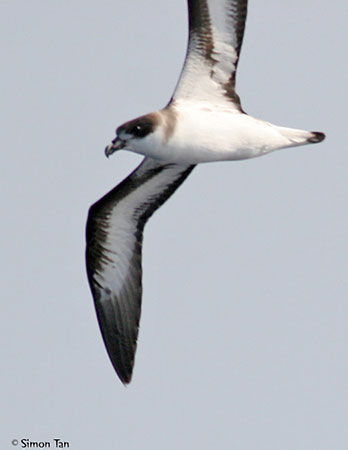
Following recent research, there are two morphological types within the species. We can find black-faced (displayed on this page) and white-faced petrels, with some intermediates.
The black-faced type has more extensive dark head than the white-faced type which is slightly larger. They are distinct entities and not colour morphs, with differences in morphology and moult timing.
RANGE:
The Black-capped Petrel breeds in Hispaniola (SW and SE Haiti and SW Dominical Republic), on Dominica and possibly in SE Cuba (Sierra Maestra). This species occurs in the Caribbean Sea and in W Atlantic Ocean.
HABITAT:
The Black-capped Petrel is highly pelagic from May to November during the non-breeding season. They gather around rich food sources. During the breeding period, it can be found along forested mountain slopes and cliffs, between 1,500 and 2,300 metres of elevation.
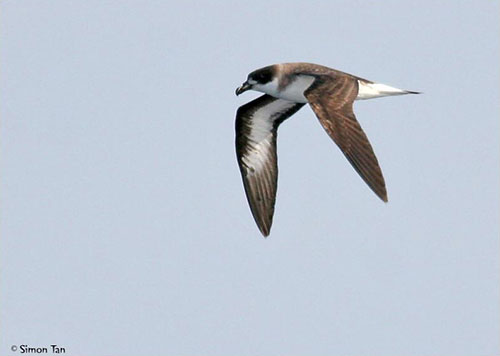
CALLS AND SONGS: SOUNDS BY XENO-CANTO
Unlike most Procellariidae, the Black-capped Petrel is apparently vocal at sea. However, it is more vocal at colony, giving nocturnal haunting calls described as long, harsh, croaking “aaa-aw, eek”, a more mellow, still drawn-out “oooooow” and a series of yelps.
The birds do much calling while flying around cliffs at night, giving the bird the local name “diablotín” or “little devil”, because their mating calls remind the sounds of evil spirits.
BEHAVIOUR IN THE WILD:
The Black-capped Petrel feeds on fish, marine invertebrates, crustaceans and squid. It forages and becomes active at dusk and during the night. The birds gather at localized upwelling that provides abundant food sources. They feed by surface-seizing or dipping, but mainly by snatching prey with the bill while flying.
It feeds in small groups of 5-20 individuals, often with other species. It may scavenge behind fishing vessels too.
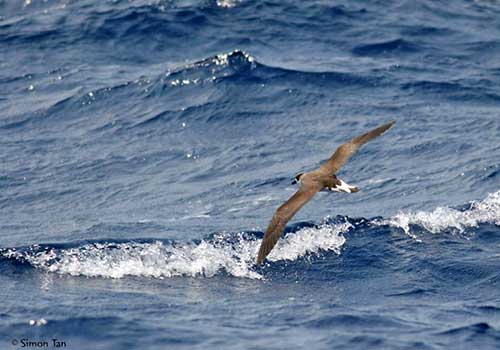
The Black-capped Petrel returns to land for breeding while giving haunting screams and cries. They perform most courtship probably in late October/November, and the displays often involve both mates flying together. The pre-laying exodus occurs in December, prior to the laying.
This species breeds in loose colonies and nests in burrows or rocky crevices on steep forested cliffs.
The Black-capped Petrel disperses over the Caribbean and Atlantic, from NE United States to NE Brazil. The species can be seen year-round in the Gulf Stream which is the main foraging area. Away from the breeding grounds, it is almost strictly pelagic.
The flight of the Black-capped Petrel is high, erratic and deeply undulating on steady wings. It often swoops upwards in great arcs above the horizon.
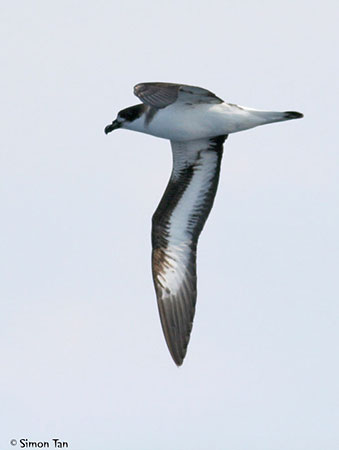
REPRODUCTION OF THIS SPECIES:
The breeding season usually occurs between late September/October to June. The pre-laying exodus takes place in December.
The Black-capped Petrel nests in loose colonies established on steep forested cliffs. The adults dig the nest-burrow in earth, or use a rocky crevice or other cavity.
They have nocturnal habits and call loudly while flying around cliffs in the darkness.
The female lays a single white egg in late December/early January, sometimes on dry pine needles or fern leaves. The duration of the incubation is unknown, but the closest species incubate during 51-54 days and both adult share this work.
The chick has pale grey down and black bill. It is fed by both parents at night. The young fledges in July and leaves the nest-burrow about 90-100 days after hatching.
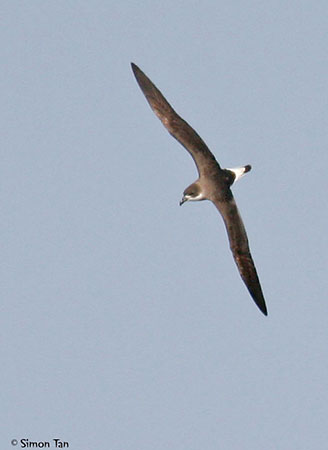
PROTECTION / THREATS / STATUS:
The Black-capped Petrel is threatened by habitat loss on the breeding grounds. However, predation by introduced rats and collection of birds by humans for food involve population decline.
The population is roughly estimated to number 1,300/3,100 pairs. The small breeding populations are fragmented and suspected to be declining.
The Black-capped Petrel is currently listed as Endangered.
